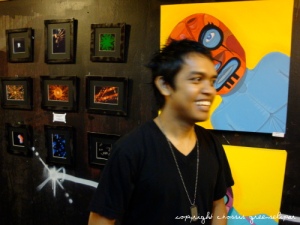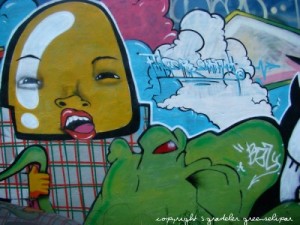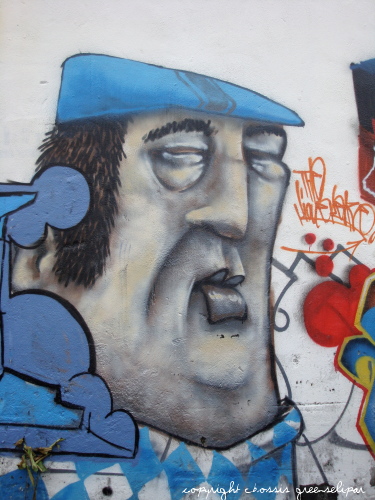A SHOWCASE OF MALAYSIAN STREET ARTS

Who are they and what do they do
They Art Studio is a gallery and studio space for Malaysian street art expression.
It was opened in December 2007 in the Central Market Annexe building by They and his brother Khairul Anuar – known as Mistawhy by the street artists’ community of Kuala Lumpur.
The gallery offers a space for Malaysian street artists to exhibit and sell their energetic, non- conventional and colourful visual art genre on canvas or any other transportable support (wood panels, bags, clothes, etc). It hosted eight exhibitions during its first year of existence. Most were group shows from the graffiti community of Kuala Lumpur (about 30 graphers). Other exhibitions were initiated through open calls with a selection of the best works.They and Mistawhy come from Batu Pahat, (240 km south of KL and about 80 km north of Johor Baru on the east coast of Malaysia, in Johor state) where they started practicing graffiti on abandoned buildings. They is a Fashion and Textile Design graduate from the Malaysian Institute of Arts and Mistawhy is a self-taught stencil artist. The two brothers run the gallery, paint, spray and draw on canvas and customized clothes. They are also committed to teaching programs and workshops for Rakan Muda (a governmental organization for the youth, sports and arts), schools and universities, as well as contribute to collective art productions commissioned by private companies and more recently, by public organizations.
What is the link between graffiti art and sustainable tourism?

Using spray paint has a pretty bad impact on the environment and an artist’s health (this is why they wear masks). This negative impact is made worse if they leave their empty cans in the streets (do they?). Should we ask the more conventional and established artists if they use organic or natural paint? I don’t think so.
Maybe these guys can be challenged to work on biodegradable wall graffiti so that the municipality won’t use an extra layer of paint to cover the graffiti or toxic solvents to wash the walls.
But consider for now the social and cultural aspects. Graffiti on public property and spaces is illegal and is considered as an act of vandalism. But we can also consider that it contributes to the changing of the public’s level of awareness, its vision and the appropriation of urban space. It can also revive abandoned places and bring colour and humour to some ugly-dirty-grey-cold-and-sad concrete walls. It can give birth to an artistic conscience or sensitivity amongst KL urbanites through non-elitist open exhibitions, new non-conventional, energetic, unpredictable forms of expression in a period when the globalization cultural uniformity is the norm.
It is sort of like a“demographic” movement (word borrowed from Eva Mac Govern, in Anti-Heroes, Off the Edge, Oct. 08, p 60-63).
What a traveller can experience

Meet the artists at the gallery : Misterwhy works there almost everyday, busy on his canvas and welcoming visitors to the gallery.
Buy Malaysian graffiti art on transportable material: the selection of art pieces are from local KL street artists like Bibichun, Orkibal, Adeputra, They, Mistawhy and others, available at very affordable prices.
- Wear Malaysian graffiti art: go home with your customized for-you-only clothes or buy one of the customised T-shirts, a pair of sneakers or a cap that is on sale within the gallery (very different indeed than the Petronas Towers or Orang Utan industrially-made T-shirt from Petaling Street).
- Visit Theyartstudio website and find out more about the graffiti community through They and Mistawhy myspace pages. Links :
Contacts
- They’s mobile (+ 60) 16 2341 362 e-mail : theyartstudio@yahoo.co.uk
- Mistawhy’s mobile (+ 60) 17 616 9934 email : mistawhy_why@yahoo.com
- Location They Art Studio, Lot 2.02 Centra Market Annexe, Jalan Hang Kasturi 50050 Kuala Lumpur
- Theyartstudio website
How to get there
It’s a five minute walk from Pasar Seni LRT (Rapid KL) station, ten minutes from Petaling Street if you plan to visit Chinatown, a or ten minute walk from Merdeka Square.
To go further we recommend

- Organize your graffiti-hunt-walk in KL: starting from the gallery, walk through Chinatown and Bukit Bintang. Ask Mistawhy for his favourite graffiti itinerary, open your eyes wide and set up your camera to immortalize the evanescent artworks.
- Read Anti-heroes, an article about Malaysian graffiti art written by Eva Mc Govern for the magazine Off the Edge, Oct. 08 issue, p 60-63.
Related posts
The Annexe Gallery.
Written by C.Bossis, Kuala Lumpur, 25 nov.08
Permission granted to reproduce for personal use only. Commercial use is prohibited.


2 comments
Comments feed for this article
May 22, 2009 at 5:28 pm
greenselipar
Did you know that this post is one of our top post in greenselipar.
It’s a shame we never had a comment.
To go further you can check this prolific article in Juice at
http://juiceonline.com/features/writing-on-the-wall/#more-12808
Catherine
November 19, 2011 at 12:27 am
Bee
The graffiti in Sg. Kelang is going to be removed by early Dec to make way for new installation in mid Dec, pls like this page for the updates – https://www.facebook.com/graffiti.kl